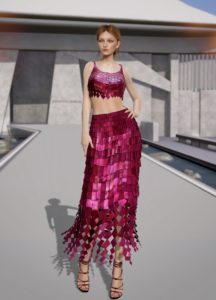Fashion is finally securing its place in the digital world of NFTs.
A carefully curated collection of fashion editors and influencers donned their digital avatars in the virtual space of Second Life this past week, for a new kind of New York Fashion Week show.
Jonathan Simkhai, a well-known designer, debuted ten new looks from his new ready-to-wear physical collection for the Fall/Winter 2022 season.
Fashion NFTs in the Metaverse
For the Second Life metaverse show, the 10 garments were transformed into true-to-life digital assets that Second Life users could purchase. Members were granted first dibs, and the remaining six garments are being auctioned off as NFTs for use in other 3D virtual environments. The day after the virtual show, Simkhai presented the full collection to a select group of journalists and other fashion insiders in New York. This acted as a stand-in for a traditional staged runway show.

Second Life Metaverse Fashion Show. Image: Jonathan Simkhai, Second Life
In an article for Vogue, Simkhai’s own words were, “It’s not like I was doing one [show] instead of the other; it was business as usual with an extra fun layer.”
A virtual runway show can potentially be viewed from anywhere. The average fashion-forward guest can see a designer’s creations in front of them with just an internet connection and a screen. Such a show can create an immersive, novel experience for viewers, as well as offer a platform for designers to explore how their designs hold up as they walk the digital runway.
Seeing as how fashion remains one of the most damaging industries to the environment, perhaps this offers an alternative, maybe even opening a door to more high-tech, body-accurate virtual dressing rooms. Such dressing rooms can also help cut down on the 30-40% return rates that plague the industry. Additionally, the Covid-19 safety of these types of shows is clearly superior to their in-person counterparts.
How Second Life Could Bridge the Metaverse and Reality
The host of the show, virtual reality gaming platform Second Life, launched in 2003. Back then the technology was so limited that they couldn’t host more than 100 people in a single virtual space. Technology has since advanced in leaps and bounds, and now Second Life founder Philip Rosedale is rejoining the project as a strategic advisor. Second Life wants to improve its platform by tweaking its social and economic aspects, in the hopes of driving up user growth.
Second Life already allows players to withdraw money from in-game sales to players’ real-world accounts. As a platform, it already has a leg to stand on as a potential host for new NFT projects, and has nearly two decades of online experience to build off of.
On the Second Life YouTube channel, the preview video for the event was met with praise. The video, generating almost 9k views at the time of this article, saw generally positive feedback. Some criticism included the lack of body diversity among the models, because after all, the digital world is a place where creating inclusivity should be easy. But to make the digital garments match up with the real-life pieces, the scale for different sizes and body types would change.
Among other feedback, the virtual fashion show seems to have helped the audience put a kind of “face to a name,” to this ‘metaverse’, the definition of which can sometimes get lost in the techno-speak soup of the financially and technically savvy. Other commenters hope that Second Life doesn’t get ‘caught up’ in the metaverse hype. Hype can make it hard to distinguish whether or not projects will have a lasting impact. And, in true internet style, one commenter typed, “That’s not good enough. Mugler did that but it was back in the 90s. I’m expecting better today.”
The runway looks may have been Mugler-esque, but the virtual show certainly didn’t happen in the 90’s. Interestingly, this project seems to carve out a path for a mixed-reality type of NFT, or a “utility” NFT. A utility NFT can be where a buyer receives a physical piece of art that matches the NFT they purchased; it could be unique access to an event, exclusive in-person memberships, or can be used for future use in the digital world, like tickets or exclusive access in-game.
The way that the 10 garments appear in real life bridges a metaverse-to-reality gap that some utility NFTs can’t–a physical twin in the real world.
The idea of hosting a real, designer-led fashion show in Second Life may be novel, but it hints at a future NFT-integrated reality in which hybrid fashion weeks could be the new normal for collectors of fashion and utility NFTs.
What’s Next for Fashion, NFTs, and the Metaverse?
3D platform Decentraland is planning a big event for March, during which Fashion Week again plots to go virtual. The no-ticket-required show promises to open up a whole world of luxury to people who normally wouldn’t have a chance to attend traditional fashion shows. Brands and investors have already grabbed up digital plots of land to place storefronts and concert halls.
In an interview with Vogue Business, Sam Hamilton, the creative director at Decentraland Foundation, said, “We want to help the onboarding process and push creativity and show everyone what is possible. We do this to show the community and other brands, ‘Hey, Decentraland is a place for shopping, everyone is wearing cool clothes and brands can release on the platform.’ It’s a way of bringing more people to the platform and making it more compelling for users.”
The pieces from Jonathan Simkhai are now available on opensea.io for sale, up until March 18.









